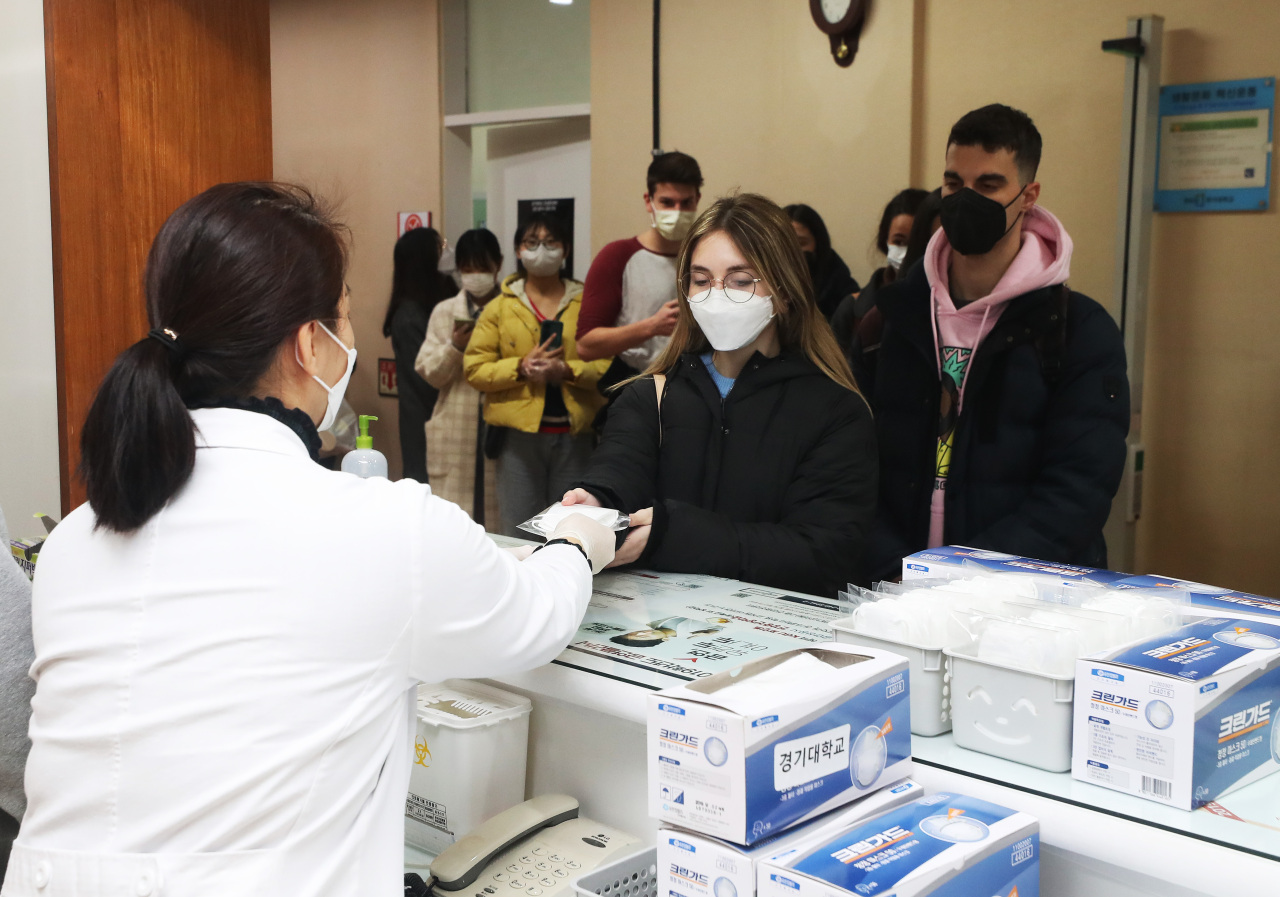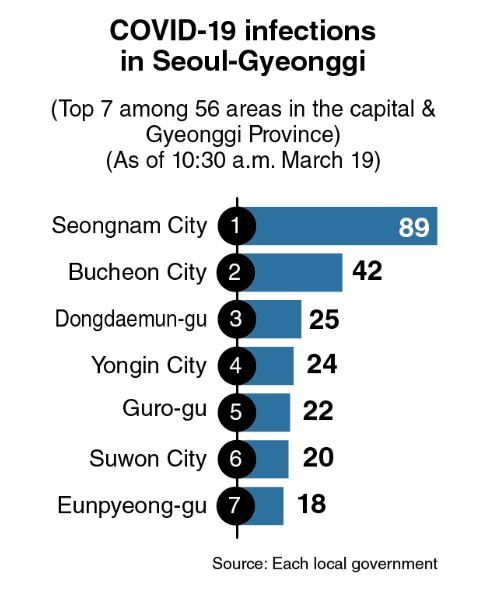[News Focus] Of 56 areas in Seoul area, Seongnam takes hardest virus hit
By Kim Yon-sePublished : March 19, 2020 - 16:36

SEJONG -- It has been two months since the first case of COVID-19 was reported in South Korea on Jan. 20.
The initial phase was limited to the Seoul metropolitan area, which encompasses the capital as well as nearby Gyeonggi Province and Incheon. The first confirmed case occurred in Incheon and the second was reported three days later in Seoul. The third was discovered in Gyeonggi Province on Jan. 26.
Though the novel coronavirus from China took its greatest toll in Daegu and North Gyeongsang Province during the months of February and March, the number of cases is still growing in the nation’s most populous regions, Gyeonggi Province and Seoul.
Gyeonggi comprises 28 cities and three counties, called “gun”; while Seoul has 25 administrative wards, or “gu.”
Of all the cities and counties in Gyeonggi, Seongnam had the greatest number of infections as of Thursday at 10:30 a.m., 89 on a cumulative basis. Bucheon was next with 42, followed by Yongin with 24, Suwon with 20, Anyang with 14, Hwaseong with 14, Goyang with 11 and Namyangju with 11. The tally for the province as a whole was 295.
Seognam was the center of two clusters, one at a hospital in Bundang-gu and one at a church in Sujeong-gu.
Bucheon also had a cluster of infections at a church, plus a number of infected residents who worked as telemarketers and commuted to a call center in Seoul’s Guro-gu, which borders Bucheon.
Among the 25 wards in Seoul, Dongdaemun-gu saw the highest number of confirmed cases with 25, followed by Guro-gu with 22, Eunpyeong-gu with 18, Gwanak-gu with 17, Gangnam-gu with 16, Songpa-gu with 16, Nowon-gu with 16, Yangcheon-gu with 15 and Gangseo-gu with 14. The tally for the capital came to 282.
Dongdaemun-gu had infection clusters at a church in Imun-dong and at an internet cafe in Hwigyeong-dong where customers went to play computer games.
Guro-gu, where the number of patients saw rapid growth, was home to the call center in Sindorim-dong where Seoul’s most prominent cluster emerge.
Local doctors have continued to warn of the risk that more coronavirus clusters could form in densely populated areas such as Seoul and neighboring cities.

The respective populations of the satellite cities Seongnam and Bucheon stood at 942,000 and 827,000 as of February, and their collective population far surpassed that of either Daejeon or Gwangju. Yet in terms of land area, Seongnam and Bucheon are far smaller than these metropolitan cities. So far, Daejeon has 22 coronavirus patients and Gwangju has 18.
A large percentage of Seongnam and Bucheon residents commute to Seoul for work, which is a risk factor in terms of regional COVID-19 control. Commuters to Seoul also make up a significant proportion of the populations of Suwon, Goyang and Yongin, all cities with more than 1 million residents.
Seoul’s Dongdaemun and Guro wards have populations of 346,000 and 406,000, respectively. By comparison, Sejong, one of Korea’s eight core cities, has only 343,000 residents.
The risk of disease transmission in densely populated areas can also be seen in South Chungcheong Province, which had 118 confirmed cases as of Thursday at 10:30 a.m.
While South Chungcheong Province has 15 administrative areas -- eight cities and seven counties -- 106 of the province’s cases occurred in its two largest cities, Cheonan and neighboring Asan.
The Cheonan-Asan area is home to 967,000 of the province’s 2.12 million residents, or 45.6 percent of the population. A core factor in the spread of the coronavirus there was a Zumba dance class.
Meanwhile, a resident of Sejong, which also saw a surge in the number of COVID-19 patients recently, raised the need to review the initial phase of the epidemic in late January. “The first patient infected with the coronavirus in Korea (confirmed Jan. 20) was a Chinese residing in Wuhan who visited Incheon International Airport. The second patient (confirmed Jan. 23) was a Korean residing in Seoul, who had visited Wuhan,” he said.
Online commenters say President Moon Jae-in should have issued a full-fledged entry ban on travelers from China in late January or early February, when the virus was fast spreading to other Chinese cities and provinces from Wuhan and Hubei province.
Even in mid- to late February, when the timing was considered belated, many Koreans were still demanding an entry ban on travelers from most parts of China. But Moon refused to heed their calls, whereas many other countries in Asia and on other continents imposed restrictions on travelers from China -- and later on travelers from Korea.
Supporters of the Moon administration disagree that the president is to blame, highlighting the disastrous outbreaks in Europe and the US since early March.
By Kim Yon-se (kys@heraldcorp.com)











![[Today’s K-pop] BTS pop-up event to come to Seoul](http://res.heraldm.com/phpwas/restmb_idxmake.php?idx=644&simg=/content/image/2024/04/17/20240417050734_0.jpg&u=)




![[KH Explains] Hyundai's full hybrid edge to pay off amid slow transition to pure EVs](http://res.heraldm.com/phpwas/restmb_idxmake.php?idx=652&simg=/content/image/2024/04/18/20240418050645_0.jpg&u=20240418181020)

![[Today’s K-pop] Zico drops snippet of collaboration with Jennie](http://res.heraldm.com/phpwas/restmb_idxmake.php?idx=642&simg=/content/image/2024/04/18/20240418050702_0.jpg&u=)